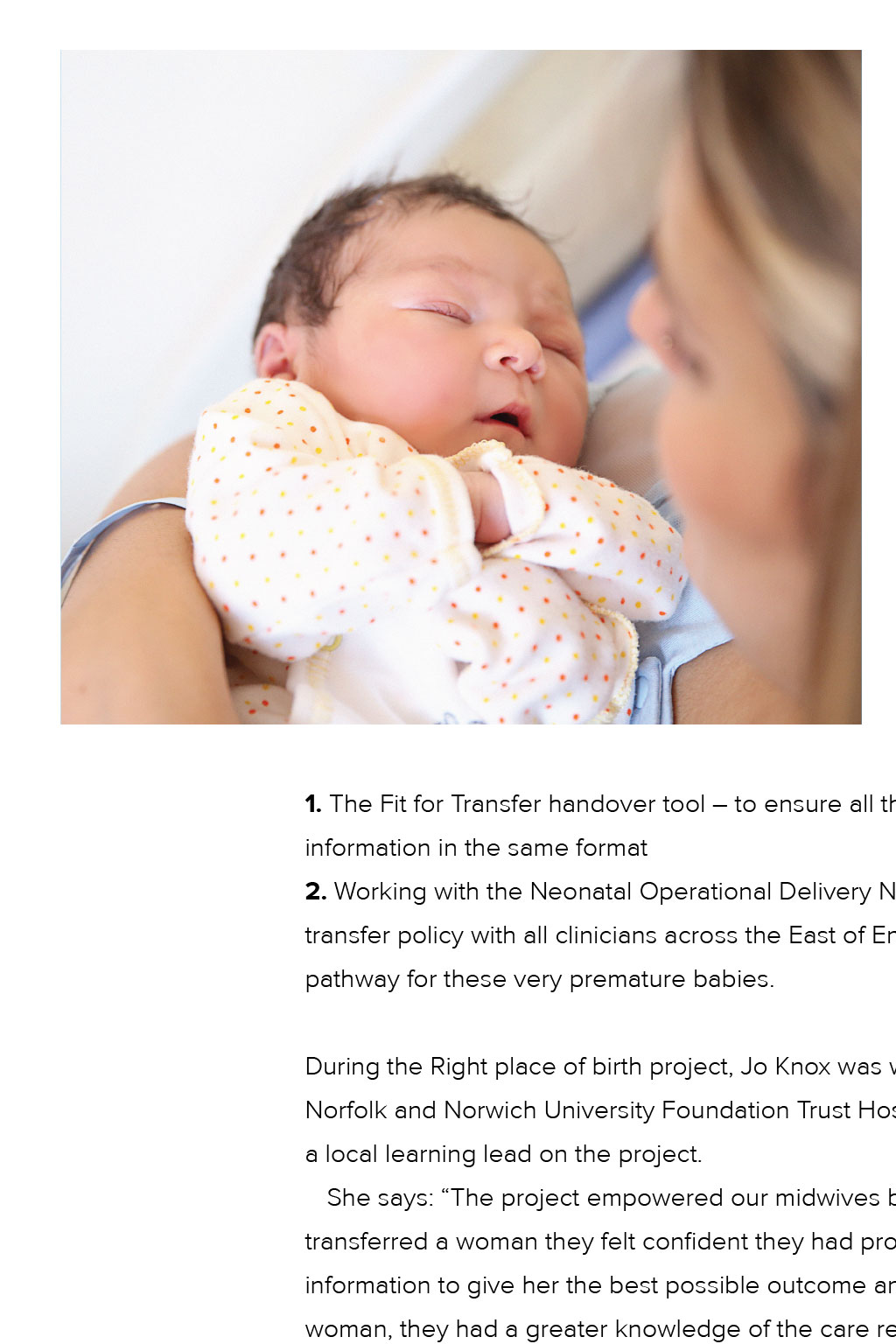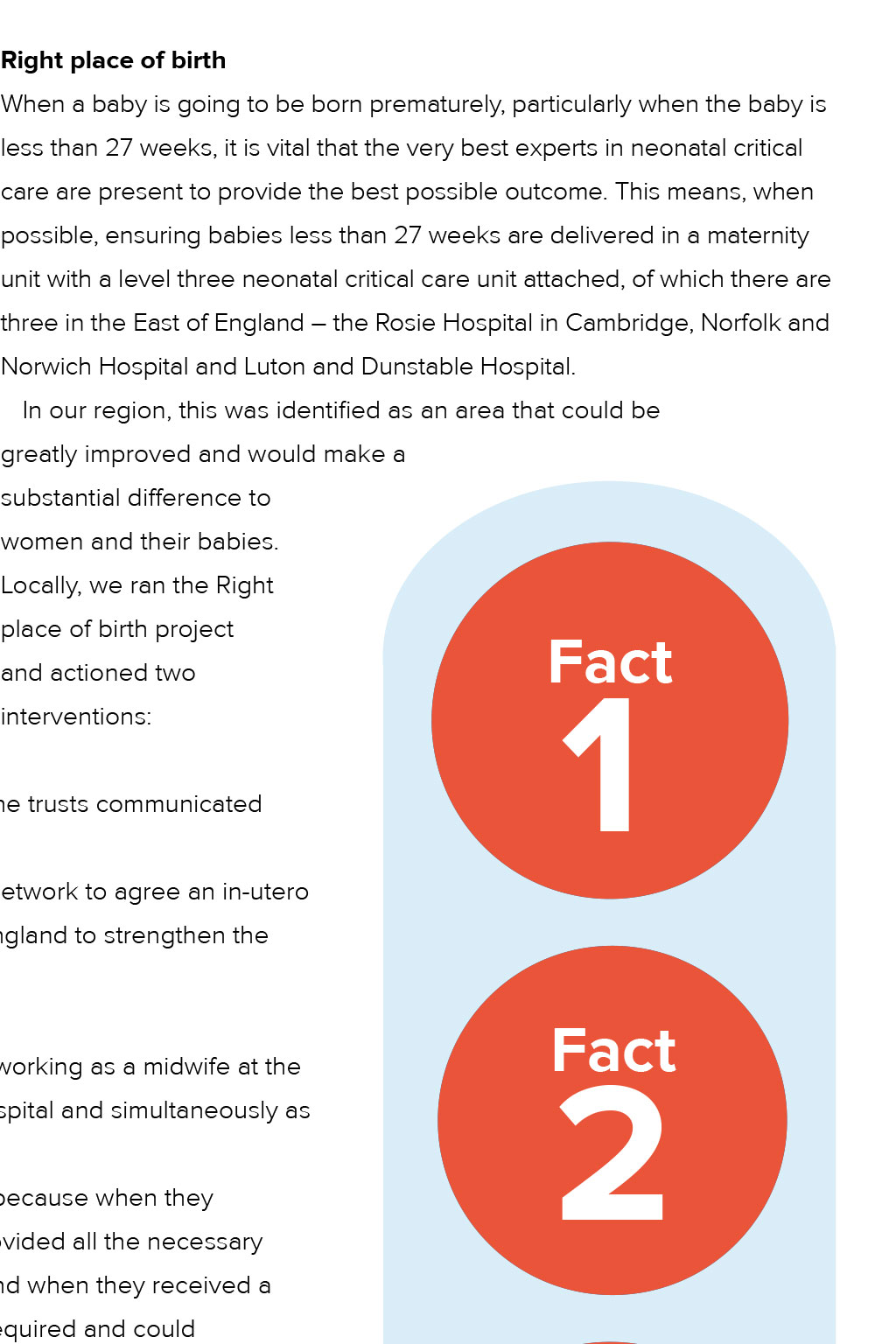


























Patient safety Driving safe behaviour change across the system Caroline Angel, Director of Patient Safety at Eastern AHSN, highlights four key activities from the team in 2019/20 T he NHS patient safety strategy: safer culture, safer systems, safer patients describes how it will continuously improve patient safety. Its impact is estimated to save almost 1,000 lives and 100 million in care costs each year from 2023/24.1 A key improvement and delivery arm of this strategy lies with Englands Patient Safety Collaboratives (PSCs), which play an essential role in implementing safer care initiatives across the system. The PSCs are a joint initiative, funded and coordinated nationally by NHS Improvement and delivered locally by the AHSN Network. Our four key activities from 2019/20 are summarised below. Talking the same talk The adoption of NEWS2 in all acute care and ambulance trust settings, alongside SBAR in the East has instilled a consistent measurement system to recognise deterioration, measure vital signs and communicate a patients status, reducing the risk of incomplete information and improper handover. However, these same tools are not standard across the whole system. So to ensure a common language, we have been working on the adoption of these tools NEWS2|thebeneltsof in care homes, where there is a substantial advantage to be gained as people standardisation aged over 65 account for 68% of hospital emergency bed days.2 Deterioration of residents in a care home setting is often first identified through a carers gut feeling that a resident isnt quite right, but that is often difficult to translate into words that all responders understand. If not detected early enough, the deterioration could be life threatening, possibly leading to a lengthy hospital admission. On average, when admitted an elderly inpatient will stay in hospital for more than 11 days,3 which could further increase the risk of physical and mental deterioration, possibly preventing them from returning to their previous residence of choice. Im thrilled to hear the project has sustained. It is a great example of a national directive implemented with local knowledge Over the past year, we have been supporting care home staff in completing their soft signs, NEWS2 and SBAR training, and 16 care homes are already testing a combination of soft signs, NEWS2 and SBAR. Through accurate assessments of deterioration and a more complete understanding of patients needs, the trials are expected to demonstrate reduced delays in the escalation of clinical care and reduced numbers of unnecessary outpatient appointments and hospital admissions. The outcome is a common language that gets the right skills to the right Jo Knox, local learning lead on the Right place of birth project patient at the right time, enabling care home staff to confidently escalate to GPs and other support staff to adjust treatment plans, medication or to initiate treatment earlier, to make advanced decisions at a time when residents and their families can be involved. A stronger start in life NEWS2 and SBAR In 2016, Better Births set out the five-year forward view for NHS maternity services in England. One of the key deliverables was to reduce the rate of stillbirth, neonatal death, maternal death and brain injury during birth by 20%, by 2020. We have been working on two projects to directly support this aim: Preventing cerebral palsy in pre-term labour (PReCePT) Right place of birth (RPoB) Preventing cerebral palsy in pre-term labour Every year, more than 8,500 women in the UK give birth very early because of complications with their pregnancy. If women go into labour at less than 30 weeks, there is an increased risk that their baby could develop cerebral palsy. We have turned this around with the national PReCePT initiative by working with clinicians in every maternity and neonatal unit in England to ensure mothers going into pre-term labour before 30 weeks are offered a dose of magnesium sulphate, which costs just 1 and reduces the risk of cerebral palsy. Over the past two years, we have been working with all 11 maternity units in the Eastern region to raise awareness of the national initiative. Each maternity unit has adopted the initiative and now record mothers eligible for magnesium sulphate treatment, those that received it and any reasons for not taking it, to learn and improve future outcomes. We started with a baseline of 61% uptake of magnesium sulphate (2017 calendar year) across the East of England and have achieved the suggested 85% uptake as one of the outcomes of the PReCePT project. In the past year, 156 mothers were treated with magnesium sulphate, which is estimated to have potentially prevented between four and five cases of cerebral palsy (based on a number needed to treat of 37). Right place of birth When a baby is going to be born prematurely, particularly when the baby is less than 27 weeks, it is vital that the very best experts in neonatal critical care are present to provide the best possible outcome. This means, when possible, ensuring babies less than 27 weeks are delivered in a maternity unit with a level three neonatal critical care unit attached, of which there are three in the East of England the Rosie Hospital in Cambridge, Norfolk and Norwich Hospital and Luton and Dunstable Hospital. In our region, this was identified as an area that could be greatly improved and would make a substantial difference to women and their babies. Locally, we ran the Right place of birth project and actioned two interventions: 1. The Fit for Transfer handover tool to ensure all the trusts communicated information in the same format From the beginning of 2020, the East of England now has Fact 81% of its premature 1 babies born in level three neonatal critical care units, an increase of more than 20% since the project initiated. 2. Working with the Neonatal Operational Delivery Network to agree an in-utero transfer policy with all clinicians across the East of England to strengthen the pathway for these very premature babies. During the Right place of birth project, Jo Knox was working as a midwife at the Norfolk and Norwich University Foundation Trust Hospital and simultaneously as a local learning lead on the project. She says: The project empowered our midwives because when they transferred a woman they felt confident they had provided all the necessary In In 2019/20, 2019/20, Fact 1,300 patients (out (out 2 of of an an estimated estimated 1,400 1,400 procedures) procedures) in in our our region region have have beneltted from at least one of the initiatives in in the the emergency emergency laparotomy laparotomy care care bundle. bundle. information to give her the best possible outcome and when they received a woman, they had a greater knowledge of the care required and could prepare accordingly. All 11 of the maternity units in the Eastern region adopted the Fit for Transfer handover tool and increased awareness of the importance of women giving birth in the right place. From the beginning of 2020 the East of England now has 81% of its premature babies born in level three neonatal critical care units, an increase of over 20% since the project initiated. Jo adds: Im thrilled to hear the project has sustained. It is a great example of a national directive implemented with local knowledge. 156 mothers treated with magnesium sulphate as part of the PReCePT programme, which is Fact 3 estimated to have potentially prevented between fourandlvecases of cerebral palsy.* *Based *Based on on a a number number needed needed to to treat treat of of 37 37 High-risk surgery benefits from quality improvements In England, around 30,000 emergency laparotomy surgeries are carried out each year for people with severe abdominal pain.4 These patients are typically elderly and frail with co-morbidities and as identified in the first Emergency Laparotomy audit in 2012 there was a high risk with mortality rates at 14.9% for all patients and 24.4% in patients aged 80 and over.5 Since then, there have been several successful improvement projects Dr Sam OHare, Neonatologist and and trials including the Emergency Laparotomy Collaborative (ELC), which PReCePT Clinical Lead, discusses was established to share local knowledge and best practice, encourage a the PReCePT programme culture of collaboration and imbed quality improvement skills to ensure sustainable change. Regionally, 10 out of 11 acute hospitals joined our ELC and agreed to share their National Emergency Laparotomy Audit (NELA) data for analysis, to understand what was working well at different sites. Through the collaboratives events, we could then focus our efforts to improve patient outcomes. We also conducted two bespoke quality improvement projects at North West Anglian NHS Foundation Trust and East and North Hertfordshire NHS Trusts Lister Hospital. In 2019/20, 1,300 patients (out of an estimated 1,400 procedures) in our region have benefitted from at least one of the initiatives in the emergency laparotomy care bundle. We are awaiting data on the final quarter which has been delayed due to COVID-19, but we are confident that a patients length of stay will have reduced because of the focus of the ELC References on improving the emergency laparotomy pathway. Share this article NHS England and NHS Improvement., (2019). The NHS Patient Safety Strategy: Safer culture, safer systems, safer patients. [online]. [Viewed 7th May 2020]. Available from https:// improvement.nhs.uk/ documents/5472/190708_ Patient_Safety_Strategy_for_ website_v4.pdf 1 The Kings Fund., (2012). Older people and emergency bed use: Exploring variation. [online]. [Viewed 7th May 2020]. Available from https://www.kingsfund.org.uk/ sites/default/files/field/field_ publication_file/older-people-andemergency-bed-use-aug-2012.pdf 2 National Audit Office., (2016). Discharging older patients from hospital. [online]. [Viewed 7th May 2020]. Available 3 References projects and innovations to improve safety in care homes Get in touch If youre interested in patient safety in our region and would like to get in touch, contact Caroline at caroline.angel@eahsn.org from https://www.nao.org.uk/wpcontent/uploads/2015/12/ Discharging-older-patients-fromhospital-Summary.pdf Healthcare Quality Improvement Partnership. National Emergency Laparotomy Audit (NELA) [online]. Healthcare Quality Improvement Partnership. [Viewed 26th May 2020]. Available from: https:// www.hqip.org.uk/a-z-of-nca/ emergency-laparotomy 4 Saunders D.I. et al., (2012). Variations in mortality after emergency laparotomy: the first report of the UK Emergency Laparotomy Network. British Journal of Anaesthesia [online]. 109(3). [Viewed 26th May 2020]. Available from: https://doi. org/10.1093/bja/aes165 5 Download the AHSN summary of